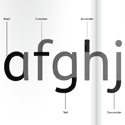accessibility
Dancing in the Dark
Brushing up on some accessibility and listening to the new 13 Letters podcast, I ran into this moving story from an interview with Haben Girma, a lawyer and the first deafblind graduate of Harvard Law School:
"Enchanted Hills, for those who don't know, is a camp for the blind in Napa, ran by the LightHouse, and many kids who are blind go to schools where they're the only blind student, or maybe they're one of two or three. I attended mainstream public schools. There were other blind students, probably, blind minority. Camp was an opportunity for one week each year, where our blindness was no big deal. At camp, it was cool to be blind. In that environment, you could focus on building up your other skills and developing community pride.
One of my stories in my book is about how I learned from a blind dance instructor that I can also do salsa, swing, merengue, and other ballroom dances. When I started out, I was shocked, how would a blind person teach a dance class? The counselors essentially said, "Go and try it and find out." It's a huge revelation for kids to meet successful confident blind adults and learn from them. Camp was an opportunity for us to do them.
I started learning dance at Enchanted Hills Camp from a blind dance instructor. She showed me the movements, the steps. Then, when I went to college, I tried going to dances. I realized it's really hard to find someone to dance with when you can't see him. What do you do? Do you stop going to the dances? For a while, I wasn't sure what to do. Then I came up with a plan. My plan was when I dance with someone at the end of the dance, ask them, "Can you introduce me to another dancer?" Then they'll introduce me to a dancer, I'll have another dance. At the end of the dance, I'll ask, "Can you introduce me to another dancer?"
When I'm dancing, I don't feel disabled. I'm fully connected with the person I'm dancing with, with the music, with the whole community. I love having that moment, where I'm fully connected and I don't have to worry about accommodations or communication. It all flows easily. When I dance, I can't hear the beat in the music, I can't see any other dances, but I can feel the rhythm and beat through the hands and shoulders of the people I'm dancing with. I focus on partner dances because there's not a physical connection through hands and shoulders when you're dancing."
I don't have a working definition of accessibility that I use, but I think this is a beautiful start.
 “FS Me is [a type family] designed to aid legibility for those with learning disability. FS Me was researched and developed in conjunction with - and endorsed by - Mencap, the UK’s leading charity and voice for those with learning disability. Mencap receive a donation for each font licence purchased.”
“FS Me is [a type family] designed to aid legibility for those with learning disability. FS Me was researched and developed in conjunction with - and endorsed by - Mencap, the UK’s leading charity and voice for those with learning disability. Mencap receive a donation for each font licence purchased.”Related: Read Regular, a typeface for people with dyslexia.

